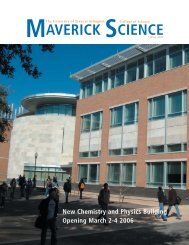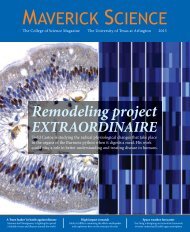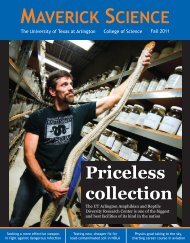Maverick Science mag 2013-14
You also want an ePaper? Increase the reach of your titles
YUMPU automatically turns print PDFs into web optimized ePapers that Google loves.
While small-scale experiments are important to science and often lead to major discoveries, when<br />
it comes to ecology it’s often necessary to take a wide-ranging and all-inclusive look at things<br />
to find solutions to complex problems.<br />
Macroecology — the study of relationships between organisms and their environment at<br />
large spatial scales to characterize and explain statistical patterns of species abundance, distribution<br />
and diversity — is what Sophia Passy uses to show how nature works. Passy, a UT Arlington associate professor<br />
of biology, has used the “big picture” approach in her research and it has helped lead to a better understanding<br />
of how one facet of a subject can affect many others.<br />
Passy has led numerous<br />
research projects utilizing a<br />
macro approach, including<br />
many environmental ecology<br />
studies which explore<br />
the response of algal communities<br />
to anthropogenic<br />
acidification, or acid deposition<br />
caused by human activities.<br />
One such study is<br />
an assessment of the effects<br />
of acidic deposition on<br />
streams in the eastern and<br />
central parts of the Adirondack<br />
Park in upstate New<br />
York. Passy is co-principal<br />
investigator of a three-year,<br />
$187,224 grant by the New<br />
York State Energy Research<br />
and Development<br />
Authority.<br />
The project’s principal<br />
investigator is Gregory<br />
Lawrence, a physical scientist<br />
with the U.S. Geological<br />
Survey’s New York Water<br />
<strong>Science</strong> Center with whom<br />
Passy has worked for years<br />
on several acid-related<br />
projects in the Adirondacks.<br />
One of Passy’s doctoral students, Katrina Pound, was lead author of a<br />
paper the team wrote about the research which was published in the September<br />
<strong>2013</strong> edition of the leading environmental and biodiversity conservation<br />
journal Global Change Biology. The study set out to determine<br />
if watershed wetlands can play a role in remediating the da<strong>mag</strong>e done to<br />
streams by acidification.<br />
“For over 40 years, acid deposition has been recognized as a serious international<br />
environmental problem, but efforts to restore acidified streams<br />
and biota have had limited success,” the researchers said in the Global<br />
Change Biology article. “The need to better understand the effects of different<br />
sources of acidity on streams has become more pressing with the<br />
recent increases in surface water organic acids, or ‘brownification,’ associated<br />
with climate change and decreased inorganic acid deposition.”<br />
“Acidification of surface waters from acid deposition is one of the most<br />
serious environmental problems in the northeast United States and northern<br />
Europe,” Passy said. “It is associated with biodiversity loss, elevated<br />
mortality, and simplified food webs. Despite numerous state and federal<br />
actions to reduce acid emissions, streams continue to experience acidification<br />
and biological communities have not returned to their pre-acidification<br />
state.”<br />
Passy, Pound and Lawrence, working with the USGS, carried out a<br />
large-scale study showing that wetlands are capable of improving stream<br />
ecosystem health in the Adirondacks, which is one of the most acid-impacted<br />
regions in the United States.<br />
“Wetlands are important<br />
not only for wellbuffered<br />
stream ecosystems<br />
as sources of iron,<br />
but also for acid-impacted<br />
streams because they contribute<br />
to the neutralization<br />
of aluminum, which<br />
reaches highly toxic concentrations<br />
in acid<br />
streams,” Passy said. “This<br />
research has far-reaching<br />
consequences for biodiversity<br />
conservation and<br />
stream management. It<br />
suggests that wetlands can<br />
be used in acid stream<br />
restoration and offers a viable<br />
alternative to the current<br />
approach for<br />
acidification remediation<br />
through liming, which is<br />
ineffective and even harmful.”<br />
For her dissertation research,<br />
Pound analyzed diatom<br />
communities from<br />
around 200 Adirondack<br />
streams that were sampled<br />
over four sampling periods.<br />
Diatoms are an environmentally<br />
sensitive group of algae and the most diverse microbial<br />
producers. Pound successfully defended her dissertation in August and received<br />
her Ph.D. in December <strong>2013</strong>. She is working as a biology lecturer<br />
and continuing to do research in Passy’s lab during the Spring 20<strong>14</strong> semester.<br />
“Studying this region is challenging because streams are acidified by<br />
both inorganic acid deposition and natural organic acidity originating from<br />
soils and wetlands,” Pound said. “My job was to count and identify the diatom<br />
species in each of the stream samples and examine the impact of<br />
these two sources of acidity on diatom diversity.”<br />
The current study is an extension of the 2003-05 Western Adirondack<br />
Stream Survey (WASS), a project for which Passy and her USGS collaborators<br />
received $486,000 from the New York State Energy Research and<br />
Development Authority. According to the USGS, the study found that acid<br />
rain had acidified soils resulting in toxic aluminum levels in two-thirds of<br />
565 assessed streams. It also found that diatoms were moderately to severely<br />
affected by acid rain in 80 percent of assessed streams; aquatic insects<br />
and related organisms referred to as macroinvertebrates were<br />
moderately to severely affected in over half of assessed streams; and recovery<br />
from acidification had been minimal in 11 of 12 Adirondack streams<br />
sampled in the early 1980s.<br />
“By teaming up, we are able to address the problem of acid rain from a<br />
truly interdisciplinary perspective, myself being the soil and water chemist<br />
and Sophia being the expert in aquatic ecology, and in particular, diatoms,”<br />
Passy and her students analyzed water samples from streams such as this one in<br />
the Adirondack Forest Preserve. Photo courtesy of Sophia Passy.<br />
<strong>Maverick</strong> <strong>Science</strong> <strong>2013</strong>-<strong>14</strong><br />
29












